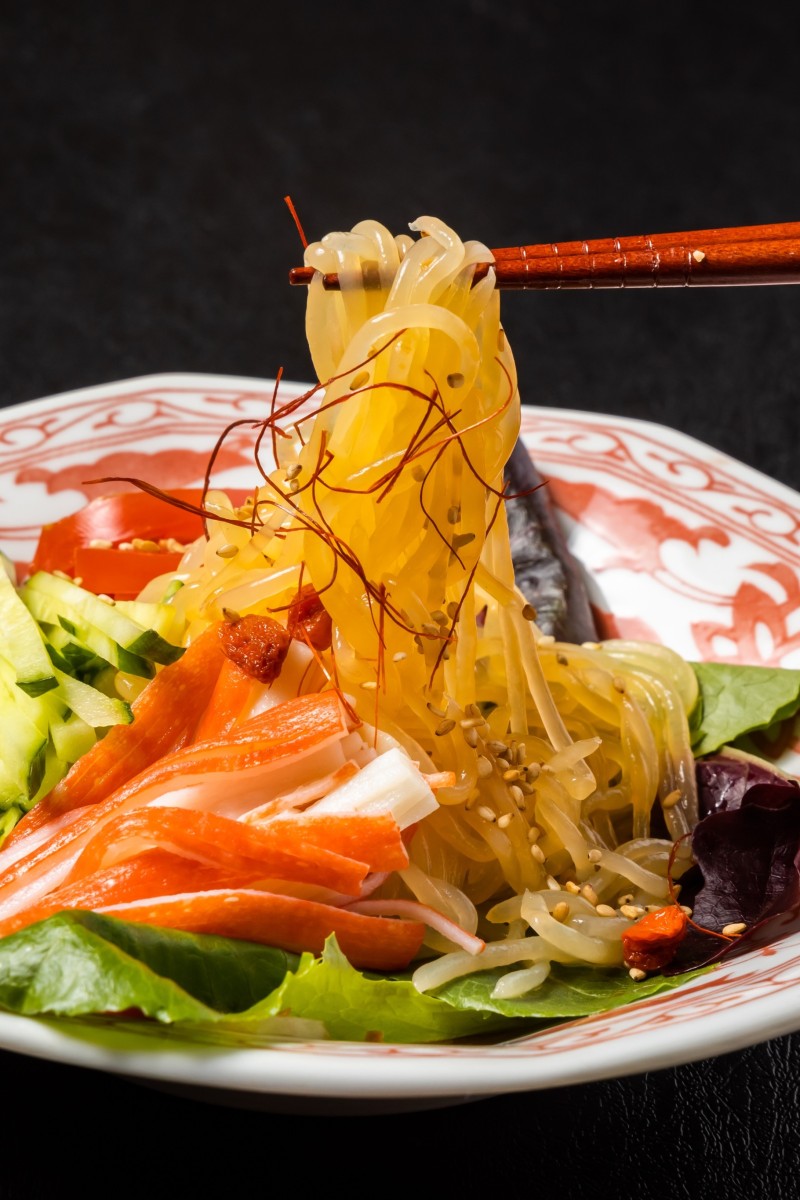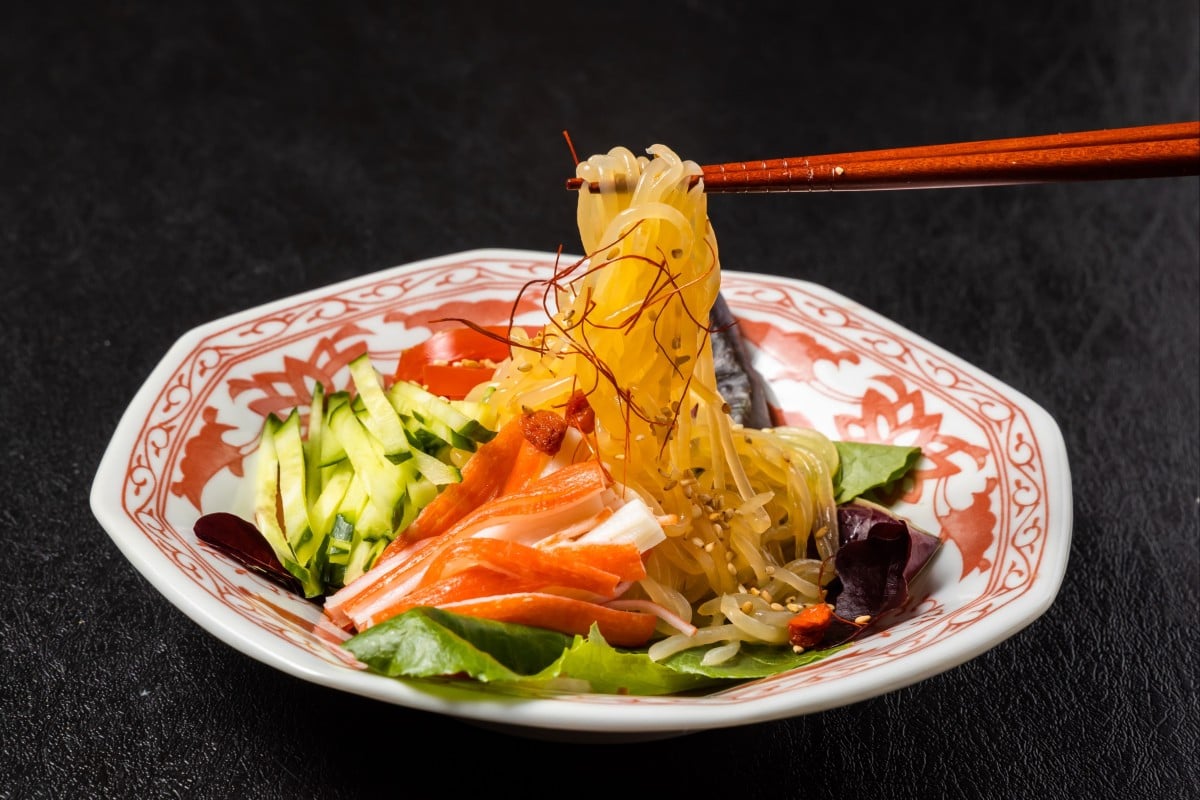
Study Buddy (Explorer): How to enjoy Asian food while on a keto diet in Hong Kong, where rice and noodles are king
- For the average Asian taste, adopting the low-carb diet could mean taking apart the foundation of many favourite dishes
- Each week, Study Buddy Explorer presents an interesting story that we have adjusted to be more accessible for all English learners
 Konjac noodles are a low-carb option for those who are on the keto diet. Photo: Shutterstock
Konjac noodles are a low-carb option for those who are on the keto diet. Photo: ShutterstockContent provided by the British Council
Read the following text, and answer questions 1-9 below:
[1] Carbohydrates play a key part in the average Hongkonger’s daily meals, from wonton noodles to roast meats on rice. Even outside these foods, rice serves as a common base on which entire Asian dishes are built, from bibimbap to biryani and sushi.
[2] Rice is also often villainised, particularly with the popularity of the keto diet, which is about eating fewer carbs. The diet promises quick weight-loss results and better energy levels. For the average Asian taste, adopting the keto diet could mean taking apart the foundation of many favourite recipes. But how feasible is it to eat little to no rice or noodles in Hong Kong, where carbs are king?
[3] The keto diet’s name comes from “ketosis”, a metabolic state in which the body produces fat-burning ketones. People on this diet rely on high-fat foods and protein to get their energy, instead of carbohydrates. Recently, the diet has gained popularity – and notoriety – thanks to how it encourages people to consume high-fat meats like steak and bacon.
[4] Going keto can be helpful for those with certain health issues, such as diabetes. But it is not for everyone as carbs can be part of a healthy meal. People should consult a doctor before trying a new diet.
[5] If you want to go keto in Hong Kong, it requires more than just opting out of rice and noodles, according to Zoe Li Tse-Wai, a nutrition coach and personal trainer. “Condiments like soy sauce and oyster sauce have hidden sugars in them and are regularly used in Chinese cuisine, which could trip over strict keto dieters looking to limit their carbohydrate intake,” she said.
[6] When ordering from “two-dish-rice” shops, keto eaters should watch out for dishes with cornstarch in their sauces, Li suggested. Instead, they should stick to steamed egg or vegetables, and meat dishes with less gravy. Hotpot is also a great choice for those who do not want to miss out on social gatherings. The meat-and-vegetable-based meal fits into the keto dietary requirements. But people should look out for sugary soup bases, such as tomato or mala soup. If in doubt, stick to clear broth.
[7] The rise of konjac and shirataki noodles – traditionally made from Japanese yams – also provide low-carb options for those who crave a noodle-based dish. These could be helpful for those starting a low-carb diet, but they should be eaten in moderation because of their low nutritional value, Li said.
[8] Typical Chinese dishes can be made keto by using low-sugar sauces and eliminating cornstarch and rice. “Most importantly, stick to eating whole foods,” Li said. “Cantonese double-boiled soups usually use meat or dried seafood and herbs. Meat dishes like lamb stew, steamed fish and stir-fried vegetables are all keto-friendly.”
Source: South China Morning Post, September 5
Questions
1. List three rice-based dishes mentioned in paragraph 1 that originate from cuisines outside Hong Kong. (3 marks)
2. In paragraph 2, the phrase “Rice is often villainised” means ...
A. rice is often portrayed as being bad for health
B. only Asians enjoy eating rice often
C. rice can often help someone eat fewer carbs
D. the benefits of eating rice are often exaggerated
3. According to paragraph 3, people on a keto diet get their energy from ...
A. sugar and protein
B. fatty meats and carbohydrates
C. fibre and carbs
D. high-fat foods and protein
4. Find a word in paragraph 4 that has the OPPOSITE meaning to “popularity”.
5. Decide whether the following statements are True, False, or the information is Not Given in paragraphs 5 and 6. Blacken ONE circle only for each statement. (4 marks)
(i) Li encourages people on a keto diet to consume more sweets for energy.
(ii) Soy sauce and oyster sauce contain sugar.
(iii) Li advises keto eaters to choose dishes with sauces made of almond flour as it is a healthier alternative to cornstarch.
(iv) Keto eaters should stay away from dishes that contain a lot of gravy.
6. According to paragraph 6, Li is most likely to instruct keto eaters to choose a … ___________ base when eating hotpot.
A. mala soup
B. clear broth
C. tomato soup
D. none of the above
7. What is the main ingredient found in konjac and shirataki noodles, according to paragraph 7?
8. List a pro and a con of eating konjac and shirataki noodles mentioned in paragraph 7. (2 marks)
9. According to paragraph 8, what three things can be removed from a typical Chinese meal to make it keto-friendly? (3 marks)
Answers
1. bibimbap, biryani, sushi
2. A
3. D
4. notoriety
5. (i) F; (ii) T; (iii) NG; (iv) T
6. B
7. Japanese yam
8. Pro: They provide low-carb options for those who crave a noodle-based dish. Con: They have low nutritional value.
9. cornstarch, sauces high in sugar, rice
